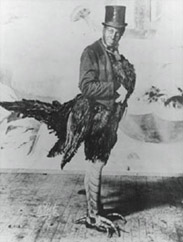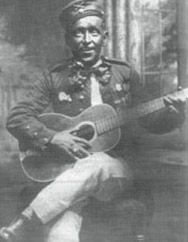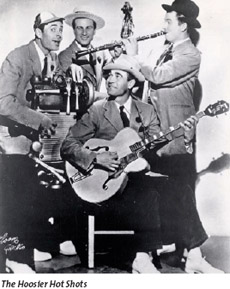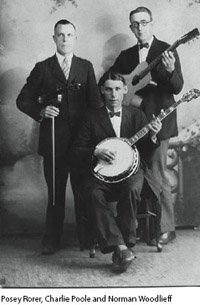Freak Folk Origins


Bert Williams & Emmett Miller
by Peter Stampfel, Part II
The Weavers had their last hit in 1952 with "Wemoweh (The Lion Sleeps Tonight)" after which they were shot down by the House Un-American Activities witch hunt. Guy Mitchell, who had a number of folkish hits in 1951, promptly recorded "The Only Red I Want Is the Red I Got in the Good 'Ol Red White and Blue" ("it's brave red, not a slave red, and it is a red that's true") just to make it clear he wasn't one of those. "Sugarbush," another folk inspired song of South African origin, also did well. Then there was a record called "Hambone," recorded by the Original Hambone Kids--three black boys between eight and twelve years old, who appeared on Ted Mack's Original Amateur Hour, a TV show that had crossed over successfully from radio. The big prize went to acts that won three weeks in a row, which the Original Hambone Kids did. They performed "Hambone" each week, without musical accompaniment, dressed in matching bib overalls and straw hats, sitting on chairs (or was it hay bales?) and proto-rapping: "Hambone, Hambone, where you been?" Then slapping their thighs in unison with "BOMP diddy diddy diddy BOMP BOMP BOMP." I loved it. Everybody loved it. And it was pure 19th century Americana, as close to authentic folk music as anything on pop radio in the last--or next--twenty years. But the strange part was that it was the most authentic folk tune in decades and such a big hit in the same year that the Weavers were blacklisted, folk-based music fled pop radio, and Folkways Records released Harry Smith's Anthology of American Folk Music. Perhaps stranger still is that this is about the time when rock and roll--the New Weird America--was born. What Unseen Force could have caused these unlikely events to occur simultaneously? And what on earth could that Unseen Force have possibly been thinking?
 Around the same time, I started reading about OWFF, I read an online post about the proper etiquette for "jamming circles," which the posting described as "a recent phenomenon" that was sweeping the nation, especially among those of college age. Proper jamming etiquette dictates, for example, that more experienced musicians should be in the center of the circle, with the least experienced musicians at the edge, with songs and keys being announced at the beginning of each song. Besides being fun for the experienced musicians, it is also an automatic teaching system for beginners as well as for those who are somewhat more advanced.
Around the same time, I started reading about OWFF, I read an online post about the proper etiquette for "jamming circles," which the posting described as "a recent phenomenon" that was sweeping the nation, especially among those of college age. Proper jamming etiquette dictates, for example, that more experienced musicians should be in the center of the circle, with the least experienced musicians at the edge, with songs and keys being announced at the beginning of each song. Besides being fun for the experienced musicians, it is also an automatic teaching system for beginners as well as for those who are somewhat more advanced.
I've also heard of an even more user-friendly variation called a "slow jam," wherein everything is played at a slower speed to accommodate the less experienced musician. In the letters section of a recent Old Time Herald, a magazine devoted to old time music and musicians, someone refers to an article that criticized slow jams for forcing songs to be played at an inappropriately slow speed. The letter writer defended slow jams as an excellent learning tool, which it truly is. A learning system that does away with the experienced/pro and beginner/amateur dividing line and is easy, fun, non-judgmental, and open to anyone is brilliant. And very '60's. One of my favorite lines of the early '60's was, "If it isn't fun, it won't get done."
My first experience with a jamming circle was actually more like a jamming cluster, and the associative word "jam" didn't occur to me at the time. It took place at the Indian Neck Folk Festival at Yale University in 1960. This was the first folk festival that I attended, and I found to my delight that besides the official performances, many of the pros present were playing in various rooms throughout the festival, and they didn't seem to mind if other musicians joined them. Although I had played violin in Junior High and High School, I'd been playing fiddle style for only a few months, and I found it an almost unbelievable opportunity to be allowed to play along with musicians who seemed light years beyond my ability. And the fact that all this went on for hours at a time, for three days, amazed me even more. But most amazing to me was how much my playing improved by the end of the festival.
I've had mixed feelings about jamming for some time now, going back to the Grateful Dead. I found their jamming to be pretty dull stuff--mostly noodling that didn't go anywhere and took too long to get there. Deadheads I have talked to admit that was often true but that sometimes music of glorious wonder and beauty would occur, your odds improving if you went to dozens of shows. A friend of mine mentioned recently that he once met Jerry Garcia in an airport and talked to him about recording versus playing live. Garcia said he disliked recording, equating it to building a ship in a bottle, while performing was like being in a rowboat on the ocean. Personally, I love both.
 Like many performers, I've long been intrigued by the idea of breaking down the wall between audience and the stage. As I just discovered from reading Dancing in the Streets, this wall is a recent development, going back to about the 1600's. They didn't even put pews in churches until the 1700's. So I thought a combination of performance and jamming circle for the Holy Modal Rounders' next reunion (let's call it a Circle Jam Jerk, because naming things is fun) would work like this: the band would be in the middle, playing acoustically, except the electric bass. Audience/participants would surround the band with whatever instruments they play. Non-playing singers would be together as a chorus. Percussionists, drums, spoons or any stuff that could be knocked on or knocked together would be grouped as well. Fiddles together, banjos together, etc. Or maybe all players could be randomly mixed. Word and chord sheets would be prepared in advance, chosen by popular fan vote. There's lots of possible ways to direct the mob. A bullhorn would be crude, but effective. Or "Fiddles only!" "Stop for 8 beats!" "Stop the song at the count of 8!" ect. signal flags are a possibility, and would be fun, but problematic. I'm sure the group consciousness would come up with some workable ideas pretty quickly. It would be fun to have everyone just whistle a break every now and then.
Like many performers, I've long been intrigued by the idea of breaking down the wall between audience and the stage. As I just discovered from reading Dancing in the Streets, this wall is a recent development, going back to about the 1600's. They didn't even put pews in churches until the 1700's. So I thought a combination of performance and jamming circle for the Holy Modal Rounders' next reunion (let's call it a Circle Jam Jerk, because naming things is fun) would work like this: the band would be in the middle, playing acoustically, except the electric bass. Audience/participants would surround the band with whatever instruments they play. Non-playing singers would be together as a chorus. Percussionists, drums, spoons or any stuff that could be knocked on or knocked together would be grouped as well. Fiddles together, banjos together, etc. Or maybe all players could be randomly mixed. Word and chord sheets would be prepared in advance, chosen by popular fan vote. There's lots of possible ways to direct the mob. A bullhorn would be crude, but effective. Or "Fiddles only!" "Stop for 8 beats!" "Stop the song at the count of 8!" ect. signal flags are a possibility, and would be fun, but problematic. I'm sure the group consciousness would come up with some workable ideas pretty quickly. It would be fun to have everyone just whistle a break every now and then.
Come to think of it, the only mass whistling I've ever heard was in a radio sing-a-long commercial in the 1940's. The entire studio audience would sing:
Tender beef, juicy pork
Known from the west coast to New York
Swift's premium franks
And then the entire audience would whistle the notes for the "Swift's premium franks" part--tweet tweet tweet-tweet.
I loved the way it sounded.
Has there ever been a whistling chorus doing four-part arrangements? Or a trio? Quintet? Orchestrated whistling mobs? I asked around, and the only harmonizing whistling anybody came up with was the two part whistling theme of the Mayberry TV show. I know there is an annual whistler's convention in North Carolina every year. I'd like to go and make some suggestions. On a more practical level, I'm getting together with three of the best whistlers I know in early '09 to attempt some whistling arrangements and general fooling around. Next would be hooking up with other good whistlers intrigued by the possibilities.
 Another characteristic of OWFF has occurred to me: how many of its practitioners are cartoonists as well as musicians. Hurley has been drawing these cartoon dog/wolf guys, Boone and Jocko, since the late '50's. They're sort of countercultural icons dating back to before there was a counterculture--which is to say, Hurley invented the underground cartoon before there was an underground. There were two musicians on the scene in the late '50's, Eric von Schmidt and Luke Faust, who were artists as well as musicians. Three if you count Woody Guthrie. But Hurley was one of the first musician/cartoonist. The only predecessor I can think of offhand was Charlie Poole's first guitar player, who actually did a comic strip about Charlie Poole and the North Carolina Ramblers. It wasn't very good. R. Crumb was another, although Hurley was more of a musician than a cartoonist, and Crumb was more of a cartoonist than a musician. Shel Silverstein had great success as a cartooist/musician. Joni Mitchell was another musician/artist who became prominent about the same time as Crumb. But my point is that in the last few years, there are more and more musician/cartoonists, Jeffery Lewis being the most prolific. He has produced at least one comic and one album each year for the last several years. Lewis, unlike Hurley and Crumb, works equally hard in both formats, even combining the two into dozens of songs that have accompanying cartoon panels. He has even done a five-part song/cartoon history of communism.
Another characteristic of OWFF has occurred to me: how many of its practitioners are cartoonists as well as musicians. Hurley has been drawing these cartoon dog/wolf guys, Boone and Jocko, since the late '50's. They're sort of countercultural icons dating back to before there was a counterculture--which is to say, Hurley invented the underground cartoon before there was an underground. There were two musicians on the scene in the late '50's, Eric von Schmidt and Luke Faust, who were artists as well as musicians. Three if you count Woody Guthrie. But Hurley was one of the first musician/cartoonist. The only predecessor I can think of offhand was Charlie Poole's first guitar player, who actually did a comic strip about Charlie Poole and the North Carolina Ramblers. It wasn't very good. R. Crumb was another, although Hurley was more of a musician than a cartoonist, and Crumb was more of a cartoonist than a musician. Shel Silverstein had great success as a cartooist/musician. Joni Mitchell was another musician/artist who became prominent about the same time as Crumb. But my point is that in the last few years, there are more and more musician/cartoonists, Jeffery Lewis being the most prolific. He has produced at least one comic and one album each year for the last several years. Lewis, unlike Hurley and Crumb, works equally hard in both formats, even combining the two into dozens of songs that have accompanying cartoon panels. He has even done a five-part song/cartoon history of communism.
So I've been sitting with this article for a while now, feeling guilty because I promised to deliver it months ago. Problem was, I couldn't think of a clear conclusion. But I finally got one. OWFF is tied to the "good" old '60's. But what is more important is that it is tied to "bad" parts of the "good" '60's that have been improved upon or are hopefully on the path towards being "healed." To give one example, there's the happy fact that it's not us against them, or hip against square anymore. This time, everyone is invited. To give another, in the '60's there was a great struggle over civil rights. This time we elected a Black president.
When I broke up with Steve Weber in 1965 (still "good" '60's), I tried to find someone else near comparable to play with. But the few people I found were only interested in working solo. There simply weren't that many really good musicians around. But what's happening now is that a critical mass--a tipping point--of amazing musicians is available, and systems, like the jamming circle, roots music based clubs and festivals, and, of course, the Internet, have all institutionalized easy ways for musicians to hook up.
Every time I go to the great club Jalopy in the Red Hook section of Brooklyn on one of the open mic nights, I meet more people I want to play with. For every interesting person to perform with in the early '60's, there are now thousands. And their numbers seem to be growing faster and faster as the appeal of joining the community of musicians becomes greater and the means of doing so becomes easier. Or perhaps the social and personal appeal have simply become more obvious. Musically speaking, these are the good old days, and they are socially engineered to keep getting better and better.
The '60's done right strikes again. The old gong is ringing more frequently and ever louder and truer. Granted, I have a sometimes overly optimistic outlook, and I've been wrong--lots--before. But not about this, I believe.
The Mother of OWFF
Is arguably Krazy Kat. Singers who cartoon, and cartoonists who sing all owe a debt to Krazy Kat: a singing cartoon. She--Krazy Kat--was sexually ambiguous but somehow clearly female. Quite a good trick, when you think about it. She would periodically play a sort of banjo-like thing and sing stuff whose speech balloon lyrics were all in caps:
PRESS MY PENTS
AN' SHINE MY SHOES
GIMME TWENNY CENTS
TO PAY MY DUES
FOR I'M GOIN' FAR A-WAAY
---- TIDDAY ----
BROOD MY TEA
AN' BAKE A KAKE
A POT POOREE
FOR ME TO TAKE
WEN I GET COMIN' BECK
---- TIMORRA ----
FLEG THAT TRAIN
AN HOY THAT BOAT
ITS GONNA RAIN
AN' I GOT NO COAT –
AN' I MAY NOT GO UNTIL
---- YETZ TIDDAY.
IN THE DOKK DOKK NIGHT
AN' THE POILY DAWN
I'LL BE SLIPPIN' TIGHT
LIKE A FENCY FAWN –
FOR I LEFF A WIKK IGGO
---- ON TOOTS DAY
She would also occasionally sing, "THERE IS A HEPPY LAND FAR FAR A-WAAY." Now, you could look at "heppy," think "hep" preceded "hip," and then think, "There is a hippy land far far a-waay," and Krazy Kat could be seen as predicting--as well as providing an archetype for--the '60's and yes, heralding herself as an Ancestor of OWFF.
The Daddy of Them All
Another cartoon song had a profound effect on many in the early '50's. In the Pogo comic strip, Pogo and the gang (Howland Owl, Albert the Alligator, Churchy Le Femme, Mam'selle Hepzibah) would, each holiday season, sing the following to the tune of "Deck The Halls":
Deck us all with Boston, Charley
Walla Walla Wash and Kala ma zoo
Nora's freezing on the trolley
Swaller dollar cauliflower ally ga roo
Don't we know, archaic barrel
Lilla boy, lullaby, Louisville Lou
Trolley Molly don't love Harold
Boola Boola Pensacoola Hulla ba loo!
Three or four friends and I used to go caroling from house to house on the south side of Milwaukee, knocking on doors and singing "Deck us all with Boston Charlie." The snow made it especially magical.
So Pogo and Krazy Kat (the former was clearly influenced by the latter), two singing cartoons, could be considered candidates for King and Queen of OWFF. Actually, when I look closely at my life, one of my earliest basic desires was to be a cartoon who sang and played music.
As far as where the music is going, I'll be all subjective. Last year, I gave up on trying to restrict the size of the group I play with. I had figured that once you got past seven, it got really hard for everyone to hear everyone else. But I kept crossing paths with people I felt I had to–-needed to–-play music with. So at this point, the others in the band are Jeannie Scofield, John Cohen, his GF Annabelle Lee (real name), Eli Smith, Hubby Jenkins, Jane Gilday, and, when they're around, Sam and Walker Shepard. Actually, the band is whoever's around when the monthly gigs occur and whoever else is fun and handy. Last gig, Eli and Jane as well as Sam and Walker, weren't there. Next time, my daughter Zoë will do percussion (playing drums is a great guy magnet, she has remarked). And last year we played with amazing violinist/vocalist Jenny Sheinman, who will be free to play with us again soon.
Another place I've seen music go lately is into more social gatherings. I fell in with a group of people who get together about once a month to sing and/or play ukulele. The songs come from all over--from "Psycho Killer" to "There's a Small Hotel"--with no decade or style over or under represented. Ukulele playing has abundant virtues--fun to sing with, inexpensive, highly portable, very easy to learn, and so small a child can play it. Of all the string instruments I've ever played, none is more inviting and accommodating. Oddly, it's about the size of a newborn baby and, like a baby, you want to hold it. And it has a really great sound.
I've also been intending to pursue just getting together with a bunch of people to sing. But not quite. Every participant should have some sort of hand-held percussion device, adding group percussion to group singing. An African/doo wop direction is just one possibility. Wouldn't it be nice if drum circles and singing circles got together once in a while? They sure could use each other.
There was an article in Ode magazine ("for intelligent optimists" is its subtitle) by Brian Eno about the abundant social, physical, and spiritual benefits of singing. He starts the article, "This is an article about singing. It's about you singing. I'm writing this because I want to encourage you to sing." He suggests people should get four person a cappella groups together "…because I believe that singing is the key to a long life, a good figure, a stable temperament, greater intelligence, new friends, increased self-confidence, heightened sexual attractiveness, and a sense of humor." He explains some physical benefits--"You use your lungs in a way you probably don't the rest of the day; you breath deeply and openly." Then he refers to what he calls the civilizational benefits--"When you sing with a group of people, you learn how to subsume yourself to the group consciousness--because a cappella singing is all about the immersion of the self into the community. That's one of the great feelings: to stop being me for a little while, and to become us. That way lies empathy; the great virtue." This as followed by excellent practical suggestions in singing together. Then he adds:
"If I were asked to redesign the educational system, I'd insist group singing be part of the daily routine. It build character and encourages co-operation."
He's sure got all that right.
In conclusion, I would like to finish by ending with a few conclusions. Get a ukulele and play it at least once a week. Dance goofy at least once a week. Sing with some friends once a week. Let your inner freak get loose occasionally. He/she is your friend, and wants you to have fun. Next, do those four things simultaneously. All this stuff wants to go viral. Help it along. In other words, play more, and encourage others to do so also. You will find yourself getting better at playing. Playing together builds healthy communities. People who are adept at playing are infinitely better at dealing with new and unexpected circumstances, and believe me, those are going to be coming ever thicker and faster.
Don't fear the future, embrace it. Pinch its bottom. Let's take it by the hand and do the crazy dance together.